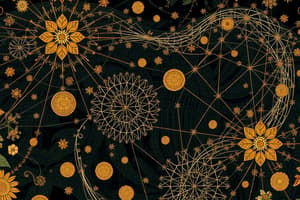Podcast
Questions and Answers
What is the relationship between a relation and a Cartesian product?
What is the relationship between a relation and a Cartesian product?
- A relation and a Cartesian product are always equal.
- A relation is a superset of the Cartesian product.
- A relation and a Cartesian product have no connection.
- A relation is a subset of the Cartesian product. (correct)
Which of the following characteristics define a reflexive relation?
Which of the following characteristics define a reflexive relation?
- The relation includes all possible pairs from the Cartesian product.
- Every element is related to itself. (correct)
- If a is related to b, then b is related to a.
- If a is related to b and b is related to c, then a is related to c.
What is the domain of a relation, in terms of ordered pairs (x, y)?
What is the domain of a relation, in terms of ordered pairs (x, y)?
- The set of all possible y values.
- The set of all ordered pairs in the relation.
- The set of all possible x values. (correct)
- The set of all possible relations between x and y.
Which of the following is an example of a symmetric relation?
Which of the following is an example of a symmetric relation?
What is the difference between a universal relation and an empty relation?
What is the difference between a universal relation and an empty relation?
Flashcards
Relation
Relation
A connection between sets of elements, similar to family relationships.
Domain and Range
Domain and Range
Domain is the x value; Range is the y value in a function.
Empty Relation
Empty Relation
A relation with no elements or pairs.
Reflexive Relation
Reflexive Relation
Signup and view all the flashcards
Equivalence Relation
Equivalence Relation
Signup and view all the flashcards
Study Notes
Introduction to Relations and Functions
- Sets are a well-defined collection of objects
- A relation is a connection between sets of elements, like the relationship between family members
- We use the Cartesian product (A x B) to check the relationship between two sets A and B
- There are pairs of values within the Cartesian product
- The relation of sets A and B always forms a subset or equal to the Cartesian product (A x B)
- Relations are defined by a specific condition
- The Domain is the x value and the Range is the y value
- To calculate the result, we substitute the x value in the equation to get the y value (Range)
- The y value is then used to create a relation pair
- The Relation (R) is a subset of the Cartesian product (A x B)
Types of Relations
- Empty Relation: A relation that has no elements or pairs (R = ∅)
- Universal Relation: A relation that contains all possible pairs in the Cartesian product
- Reflexive Relation: A relation in which every element is paired with itself, like (a, a), (b, b), etc.
- Symmetric Relation: If a is related to b, then b is related to a (a, b) and (b, a) are both part of the relationship
- Transitive Relation: If a is related to b, b is related to c, then a is related to c. If (a, b) and (b, c) are in the relation, then (a, c) is also part of the relation
- Equivalence Relation: A relation that is reflexive, symmetric, and transitive
Studying That Suits You
Use AI to generate personalized quizzes and flashcards to suit your learning preferences.




